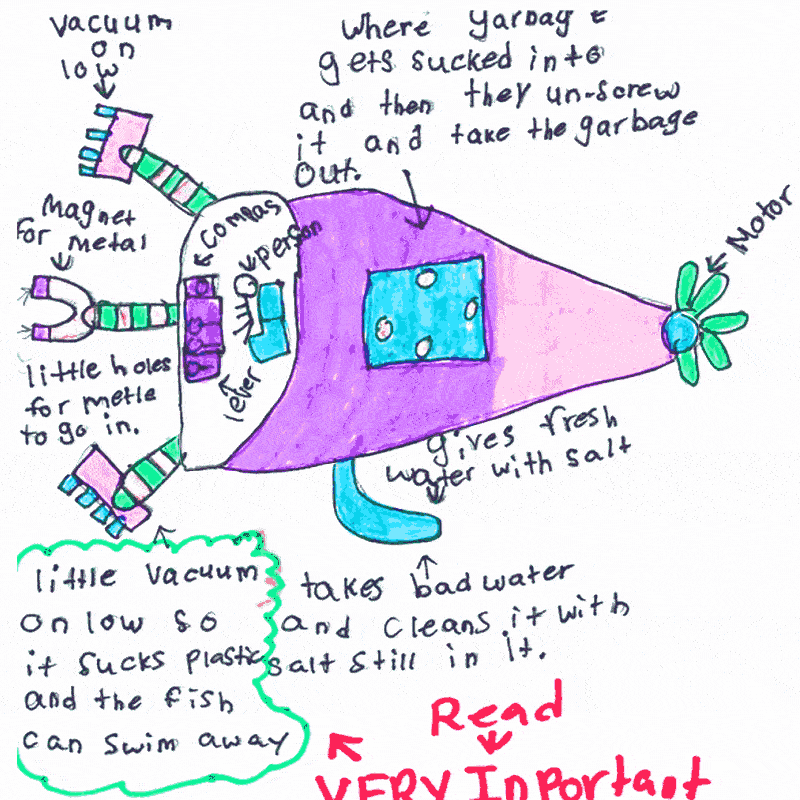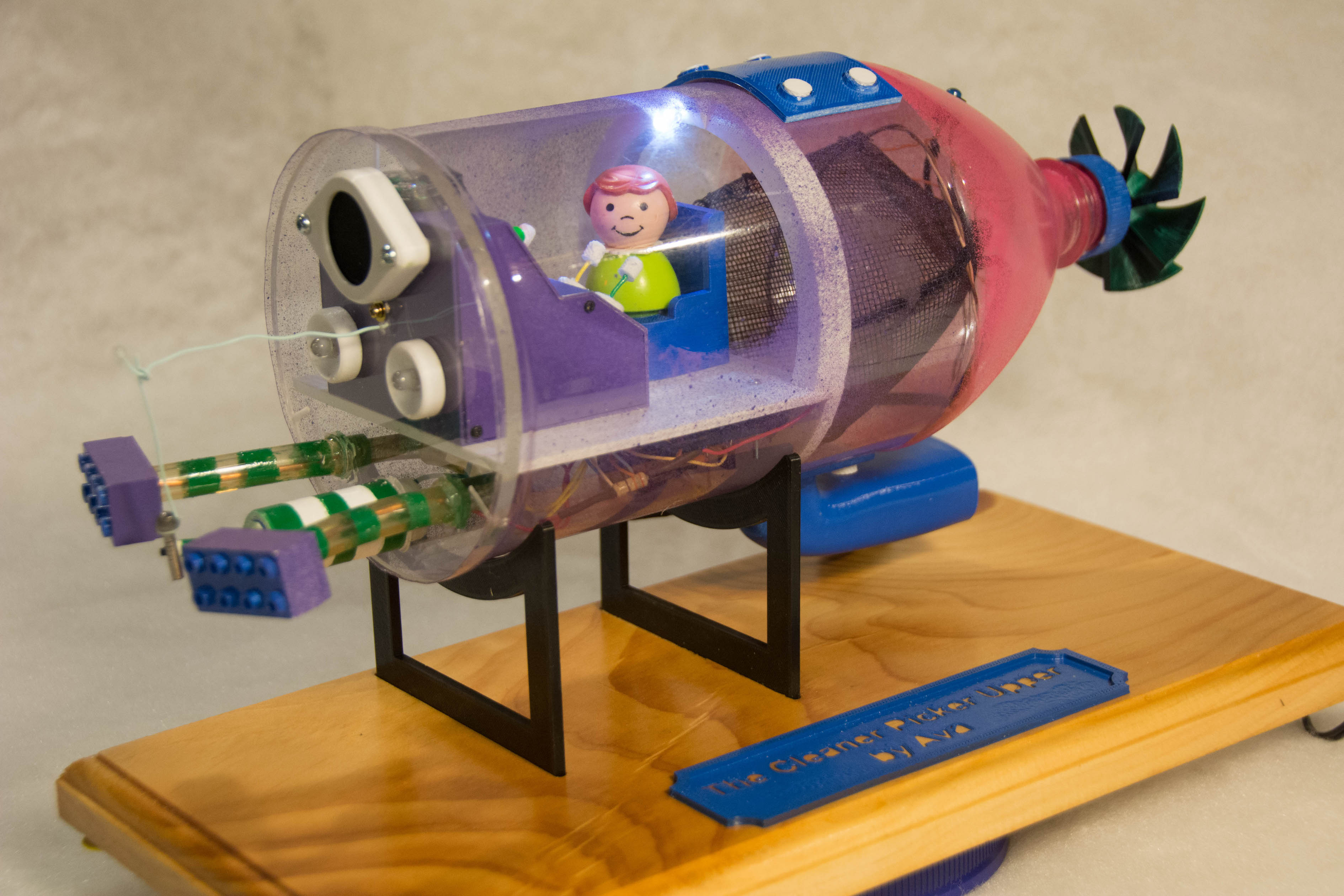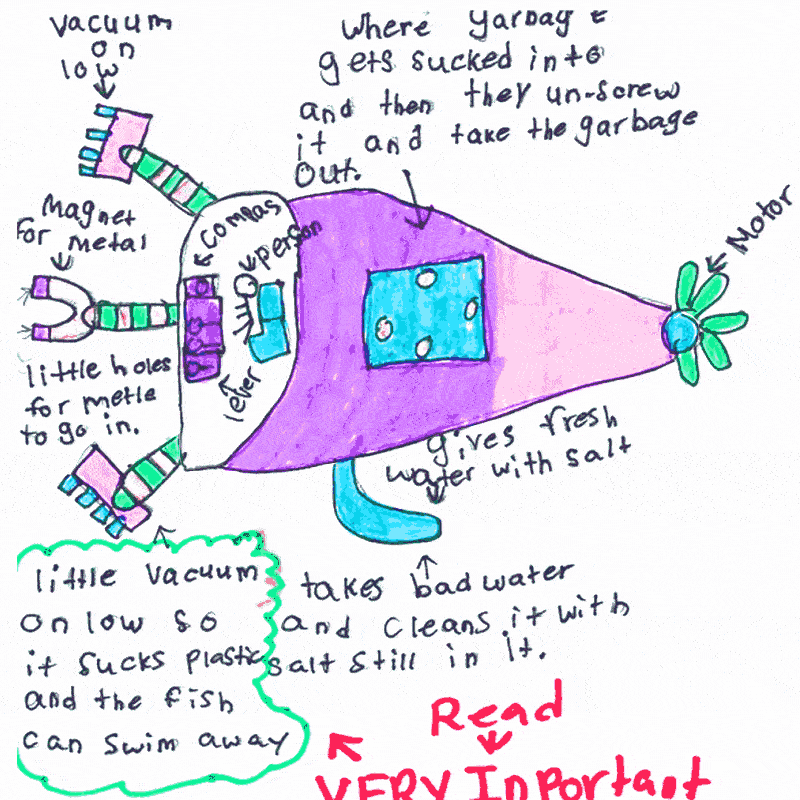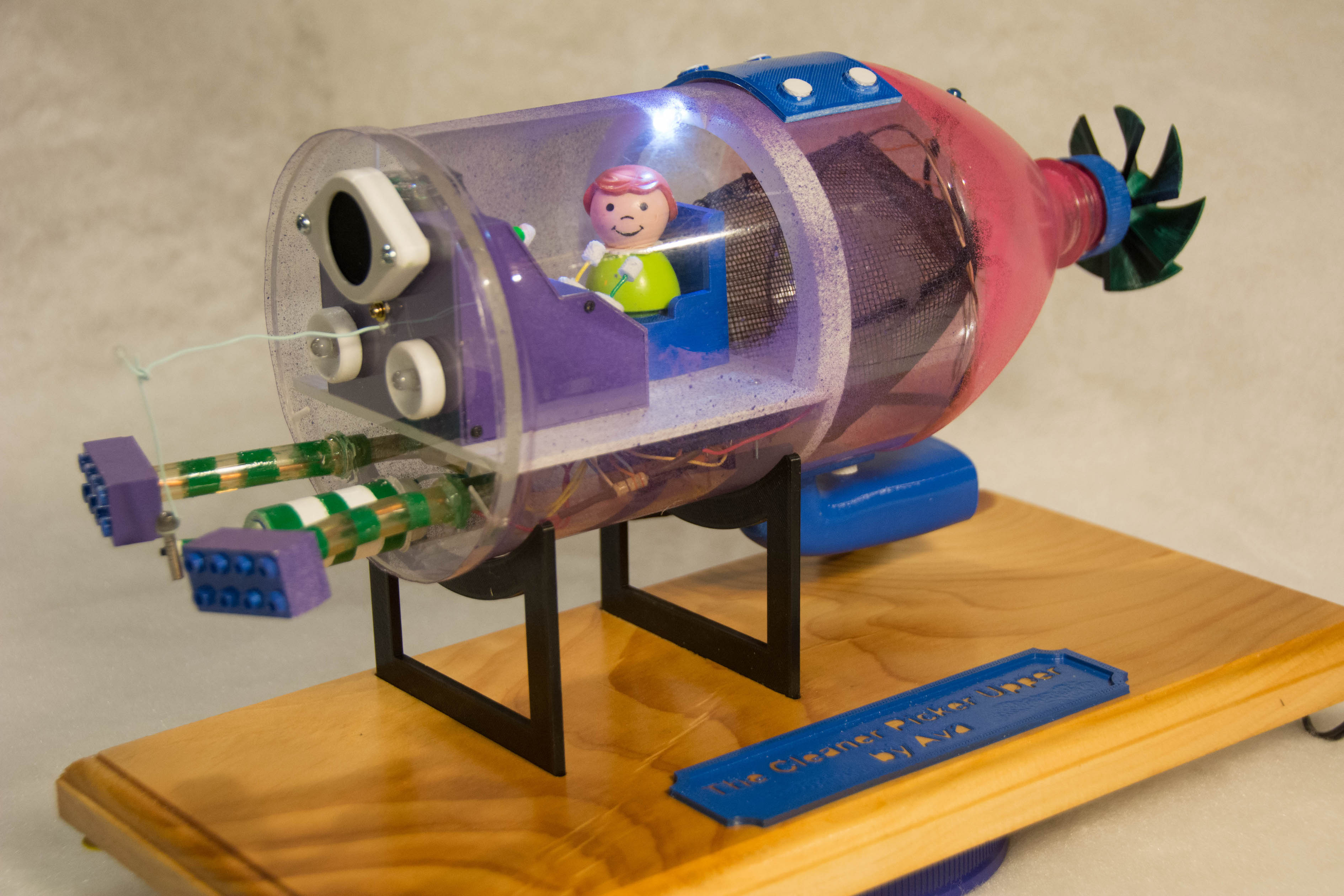The Cleaner Picker Upper


This idea has been brought to life

As a retired physicist, I like to use my experience in electronics and skills in woodworking and 3D printing to create solutions to every day’s problems. I like to recycle obsolete electronic appliances and devices and harvest many of the still functioning components that often find a good use in my creations. I find the Little Inventors ideas a challenge to my creativity: how to reduce to practice, to make realistic models of the children’s extremely interesting conceptual ideas.
Jean, a retired physicist from Saint-Lazare worked with Ava to make her ideal into a real model!
Visit the online Protect our oceans exhibition to find out more!
Blog entries

Well, this has been a very interesting project. Ava's idea of a submarine to clean the ocean water of plastic and metal pollution was very clever. I think I was able to bring her inventive idea to life through this little model. Once powered up, the model randomly switches on the propeller to drive the submarine, the beam lights to help guide the vessel through the murky waters, the sonar to detect potential obstacles or avoid schools of fish and finally an electromagnet to pick up metal debris. The waste is collected in a bag while the filtered water is channeled through the exhaust manifold.

I wanted a nice stand to support the cylindrical vessel. I used a piece of pine wood, made nice edges with a router and apply a couple of coats of varnish. I 3D printed two plastic saddles that will be used to support the vessel and a nameplate as well that a spray painted blue.

Satisfied with the initial test with the microcontroller, I have assembled the electronics (l0ts of wire cutting and soldering) under the cockpit (see picture). The model is now pretty much complete. The video gives a good view of the model in action, with random turning ON and OFF of the lights, the propeller motor and the magnet. All that is needed now is some sort of stand with a saddle to hold the model.

The tiny microcontroller chip will be the brain of the model and will control all the animation and sound effects. I developed the code in C language on the computer and programmed the microcontroller though a small programmer box linked to the computer with a USB cable. After some debugging (things rarely work right the first time, which is an opportunity to further develop analytic skills...) the "brain" worked to my liking. Before assembling the electronics and doing all the soldering, I tested the brain on the small programming/testing board using the built-in LEDs to verify and fine tune the brain function, i.e. the random animation of the motor, magnet and flashing of the various lights (see the attached video).

Models are always more interesting when they are brought to life with sound and motion. I introduced a sonar (a miniature speaker to be affixed on the front window of the vessel) that will broadcast pinging sounds continuously. There are also two beam lights at the front of the vessel. The control room itself with be illuminated with a ceiling light. I also wanted the control desk to display four lights to display the status of the various functions. The manage the animation, I am planning to use a small microcontroller to turn on and off in a random fashion the beam lights, the propeller and the magnet. The attached pictures show the schematic and the parts used for the electronics.

The water containing waste material gets into the vessel by way of the vacuum pick-ups, then underneath the control room and finally into the section at the back of the vessel. In that section the water enters a net which collects the big and small particles and the purified water exits the vessel through the water exhaust manifold (refer to Ava’s drawing). To design the manifold with its artistic curves, as previously mentioned, I had to master the “sculpting” function in Fusion 360. After watching a couple of YouTube videos it was fun to pull and stretch the various faces of a starting cube to form the desired shape (see the drawing), a bit like playing with Play-Doh. For the net used to store the waste, I used material from a discarded window screen (thanks to the local squirrels) that I sewed into the required shape. I also made the access port with its decorative rivets on the 3D printer. I dipped the as-printed PLA piece on the flat printer bed in very hot water for 20 seconds and bent it to the right curved shape.

For the two arms extending in front of the vessel that will suck the water in to filter plastic waste, I used two small Lego bricks. I drilled holes through the stubs, made backing plates on the 3D printer and join brick, plate and plastic tube together with epoxy glue.

I liked Ava’s idea of using some sort of magnet to capture metal debris from the ocean water. With the objective of putting some animation into the model, I decided to push this idea a bit further and therefore include a small electromagnet. To do so, I repurposed a small actuator that I had in my junk pile (it probably came from a recycled printer). I extracted the coil and used two nails that I shaped and cut in such a way to reproduce the shape shown in Ava’s drawing. By turning the coil current ON and OFF, I am able to turn the magnetic field ON and OFF as shown in the attached video.

I did the design of the control room on Fusion 360 then fabricated the parts (desk, side panel, floor, pilot chair, ring for the partition to the back of the ship) on the 3D printer.
I cut the front window and the back partition out of acrylic (Plexiglas) using a scroll saw equipped with a blade made for cutting plastic. With the current COVID situation Plexiglas is hard to find in stores nowadays but luckily I had some leftover in stock from previous projects.
I then put things together temporarily to check the fit with the main vessel (a.k.a. soda bottle) and it matched nicely. I will remove the white protective sheet on the clear acrylic plastic later in order to avoid scratching the pieces while doing the rest of the project.

Today I had my first conference call with Ava, the Little Inventor of the Cleaner Picker Upper. It was great to finally get to meet her in person (well, virtually anyhow…) and exchange ideas with her. Her teacher, Mr. Ashley and Jill Bennison of Little Inventors were there to facilitate the call. Ava seemed pretty happy with my rendition of her original idea (so far anyway). When I asked Ava about other ideas that came to her mind when she was creating the original concept of the CPU, she did mention that the idea of propelling the vessel with a kind of “whale tail” instead of a conventional propeller had crossed her mind. I found this idea quite interesting. I remember reading in some scientific magazine or journal that the swimming motion is one of the most efficient way (less energy consumption) to move an object (fish, underwater vessel, etc.) in water. On one hand I am happy that she chose to use a propeller since it was easier to make a model, although I must admit that she triggered my curiosity. I might revisit this idea on a future project. I also told her that making a model of her invention had forced me to develop new maker skills, particularly in the area of “sculpting” artistic shapes in 3D on the computer. As a matter of fact I subsequently applied this newly acquired skill to the other project I am working on (ref.: the Clean Machine). Thanks Ava !

Next I needed a propeller. This was a perfect project for my 3D printer but first I needed to design it. I regularly use the computer CAD software Fusion 360 for designing various things in 3D although I must admit that I am far from being an expert.
It is actually quite exciting to be able to create various objects in three dimensions with just a few keystrokes on the computer keyboard.
For this propeller project, I was lucky: I was able to repurpose a fan design that I had done more than a year ago to repair my wife’s hair dryer. I remember spending a good part of an afternoon designing a new fan to replace the broken one. Since I had done a parametric design with Fusion 360 (defining the key dimensions not with fixed numbers but rather with variables), I was able, with just a few keystrokes, to reduce the original fan dimensions to the right scale for the propeller and adjust the hole diameter for the shaft to fit the miniature motor I had selected. I used white PLA on the printer and put a first coat of paint to match the color on Ava’s drawing. I turned out pretty good.

I really liked Ava’s idea of using an underwater vessel to capture plastic and metal waste. Thinking about ways to make a working model, I quickly came to the idea of using a recycled 2-liter soda bottle. The bottle cap would house a miniature DC motor to drive a propeller and I would cut the bottom of the bottle and insert an acrylic window behind which would be the cockpit.

